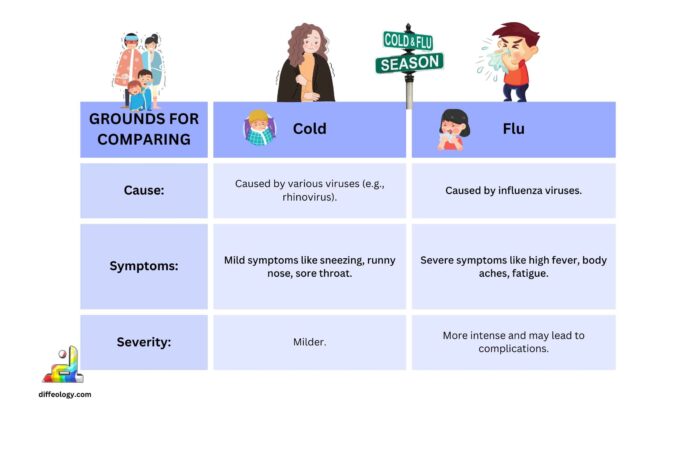Though the common cold and the flu are respiratory diseases, they are caused by two drastically different viruses with very different symptoms. A common cold is relatively minor, lasts about a week, and affects more than 1 billion people every year, especially in the winter. Symptoms are mild, including runny nose, sore throat, and sneezing. However, people who contract flu viruses will have much more serious conditions like pneumonia. It is a common myth that every year, between 9 million to 41 million people get the flu in the United States, and it commonly brings such a serious condition: high fever, body aches, and extreme tiredness. Knowing the difference between a cold and the flu is important, as it enables people to take the right steps in faster recovery and even prevents spreading to others.
Main Difference Between a Cold and the Flu
A cold usually starts slowly, while flu symptoms come on suddenly, often within a few hours. With a cold, fever is rare. If you have the flu, a fever is common and can be high, sometimes lasting 3-4 days. Body aches are mild or absent with a cold, but the flu causes more intense body aches and pains.
Cold Vs. Flu
What is a Cold?
A cold, also known as the common cold, is a mild infection of the nose, throat, and upper airways. Typically, a cold has different viruses that cause it. Of those, one is a rhinovirus. You catch a cold from another person who has the infection or when you come into contact with viral reservoirs associated with doorknobs or keyboards. Symptoms include nasal congestion and rhinorrhea, sore throat, sneezing, coughing, and sometimes mild fever. Most last 7-10 days and resolve on their own without medical treatment.
Read Also: Difference Between Coronavirus and Rhinovirus
The common cold per se is not so serious but can easily be transmitted to thousands of people. Millions of people suffer a cold every year, and the average adult suffers 2-3 colds a year and children as many as 6-8 a year. For the prevention of a cold, one should be in the habit of frequent hand-washing, and not having close contact with the patient would also ensure prevention. Since there is no remedy for the common cold, rest should be provided, plenty of fluids should be had, and over-the-counter medicines used to ease symptoms until the body fights off the infection.
What is the Flu?
The flu or influenza is a contagious respiratory illness caused by influenza viruses. Mostly spread within the nose and throat; at other times, the infection enters the lungs. A person acquires an infection when breathing in droplets released when an infected person coughs, sneezes, or talks or by touching surfaces contaminated with the virus. Some possible symptoms are fever, chills, body aches, sore throat, cough, and fatigue. Flu is worse as compared to a cold. Flu can provoke severe complications like pneumonia- especially in the elderly, young children, and also seriously weak persons.
Read Also: Difference Between Type 1 and Type 2 Diabetes
There are millions of flu cases reported annually, and flu kills 12,000 to 52,000 persons per year in the United States. Flu shots are widely administered and remain the best protection against flu as they can reduce the risk of getting infected in the first place as well as reduce the severity of symptoms if someone does get infected with it. Antiviral drugs may also be prescribed to shorten the course of illness if taken early enough after the onset of symptoms. To stay protected, one is required to receive a vaccination every year since the flu season typically starts in the fall with good hygiene practices like hand washing.
Comparison Table “Cold Vs. Flu”
| Onset | Slow | Sudden |
| Fever | Rare | Common |
| Fatigue | Mild | Severe |
| Aches | Mild | Severe |
| Chills | Uncommon | Common |
| Sore throat | Common | Sometimes |
| Runny nose | Common | Sometimes |
| Sneezing | Common | Sometimes |
| Cough | Mild | Severe |
| Headache | Rare | Common |
| Chest pain | Mild | Common |
| Duration | 3-7 days | 1-2 weeks |
| Contagious | Yes | Yes |
| Energy level | A normal or slight decrease | Very low |
| Treatments | Rest, fluids | Rest, fluids, antivirals |
| Vaccine | No | Yes |
| Hospitalization | Rare | Sometimes |
Difference Between a Cold and the Flu in Detail
Get to know the Difference Between Cold Vs. Flu in Detail.
Causes of a Cold vs. the Flu
Common cold and flu are two different respiratory illnesses caused by different viruses. The common cold is most often caused by rhinoviruses, but influenza viruses cause flu. Rhinoviruses survive for hours on surfaces, thus getting a common cold is not that difficult. However, influenza viruses tend to be more easily spread in the air especially during the colder months.
Both are contagious diseases. Although the flu is far more virulent in its spread, you are more likely to get colds by exposure from contact with another person or by contact with surfaces contaminated with the virus. The flu, in contrast, is spread by inhaling droplets that are suspended in the air when an infected person coughs, sneezes, or talks.
Symptoms and Their Severity
Typical cold symptoms are generally not bad and only develop gradually. These include sneezing; a stuffy nose; and a sore, sometimes irritated, throat. Adults rarely become feverish, but children may. You may not feel particularly crummy even to be bothered to go about your day if you have a common cold, but you would be feeling a little off.
The flu strikes harder and faster. Common symptoms include high fever, muscle aches, and extreme fatigue. Flu symptoms often appear in such a sudden fashion that it feels like being hit by a truck. You will also experience chest pains, headaches, and chills.
Duration of Illness
Most often, a cold lasts around 7 to 10 days. Some symptoms, like a runny nose and cough, resolve with time; they tend to subside on their own. Meanwhile, resting, drinking plenty of fluids, and using over-the-counter medications are usually helpful in the relief of symptoms from a cold.
It may take a whole week up to two weeks before recovery is complete. The most acute symptoms, such as fever and aches, usually do not last more than 3 to 5 days, but overall weakness and fatigue may persist for a couple of weeks.
Complications
The cold rarely leads to serious medical conditions. Occasionally, a cold may trigger a sinus infection or an ear infection, but it is usually only very slight and passes over very quickly.
The flu more often causes worse complications, especially in high-risk groups: the elderly, young children, and people with compromised immune systems. The flu may trigger pneumonia and bronchitis, and, in extreme cases, a person might even be hospitalized or even die.
Preventive Measures
Regular washing and avoiding face-to-face contact can also help in diminishing the chances of catching a cold. Hand sanitizers and disinfection of ordinary surfaces may also prevent the development of the cold virus.
The best defense against the flu is receiving an annual flu shot. An annual flu vaccine teaches the body to recognize the virus and begin fighting it before it causes illness. Good hygiene practices, including hand washing and covering the mouth when coughing or sneezing, also can help control the spread of the flu.
Treatment Options
Common colds can never be cured, but you can relieve its symptoms with over-the-counter medications, such as decongestants and pain relievers. Drinking warm liquids and using saline sprays can also be helpful. Ample rest is a great aid.
In addition to antibiotics, antiviral drugs, such as Tamiflu, can be prescribed by a doctor for the flu. These medications are most effective when given within the first two days of showing symptoms. Unlike the cold, where over-the-counter medications are adequate, at times, flu patients need to see a doctor to avoid complications.
When to See a Doctor
Most of these colds don’t need a visit to the doctor. You should go for a doctor’s advice if you have a severe sore throat, fever, or if symptoms persist longer than 10 days.
If you have influenza with difficulty in breathing, chest pain, or confusion, you should consult your doctor right away. Others who are prone to getting the flu, such as the elderly and young children, must always consult a doctor immediately when they suspect having influenza to prevent any major health complications from arising.
Key Points Showing the Difference Between a Cold and the Flu
Fatigue
Fatigue is mild with a cold but can be extreme and last for weeks with the flu.
Sneezing
Sneezing is common with a cold but happens less frequently with the flu.
Cough
A cold often brings a mild to moderate cough, whereas the flu tends to cause a severe, dry cough.
Runny Nose
Colds typically cause a runny or stuffy nose, but it’s less common with the flu.
Headache
Headaches are rare in colds but are common with the flu.
Sore Throat
A sore throat is common in colds but less frequent in flu cases.
Chills
Chills rarely occur with a cold but are common with the flu, especially with a fever.
Fatigue Duration
In the cold, fatigue might last a few days, but flu-related tiredness can persist for weeks.
Appetite Loss
Loss of appetite is rare with a cold but more common with the flu.
Severity of Illness
Colds are generally mild, while the flu can make you feel much sicker and weaker.
Breathing Difficulty
Breathing problems are rare with a cold, but flu can cause chest discomfort and breathing issues.
Sinus Pressure
Sinus pressure and congestion are more common in colds but less frequent in flu cases.
Contagion
Both are contagious, but flu spreads faster and affects more people in a short time.
Risk of Complications
Flu is more likely to lead to serious complications like pneumonia, while colds rarely do.
FAQs: Cold Vs. Flu
Conclusion:
Though both the common cold and flu might share some symptoms, the flu is much more serious and, in extreme cases, can lead to cases of hospitalization; typically, this happens with vulnerable groups, such as young children and older adults. Simple things such as hand washing, flu shots, and staying home when on sick leave are only a few examples of the best preventatives against both infections. Of course, if you are in doubt about which one it is, a cold or the flu, you must see a doctor, specifically if symptoms worsen. This will keep you and others safe during the cold and flu season. Treat yourself wisely, as now you know the difference between a cold and the flu.



